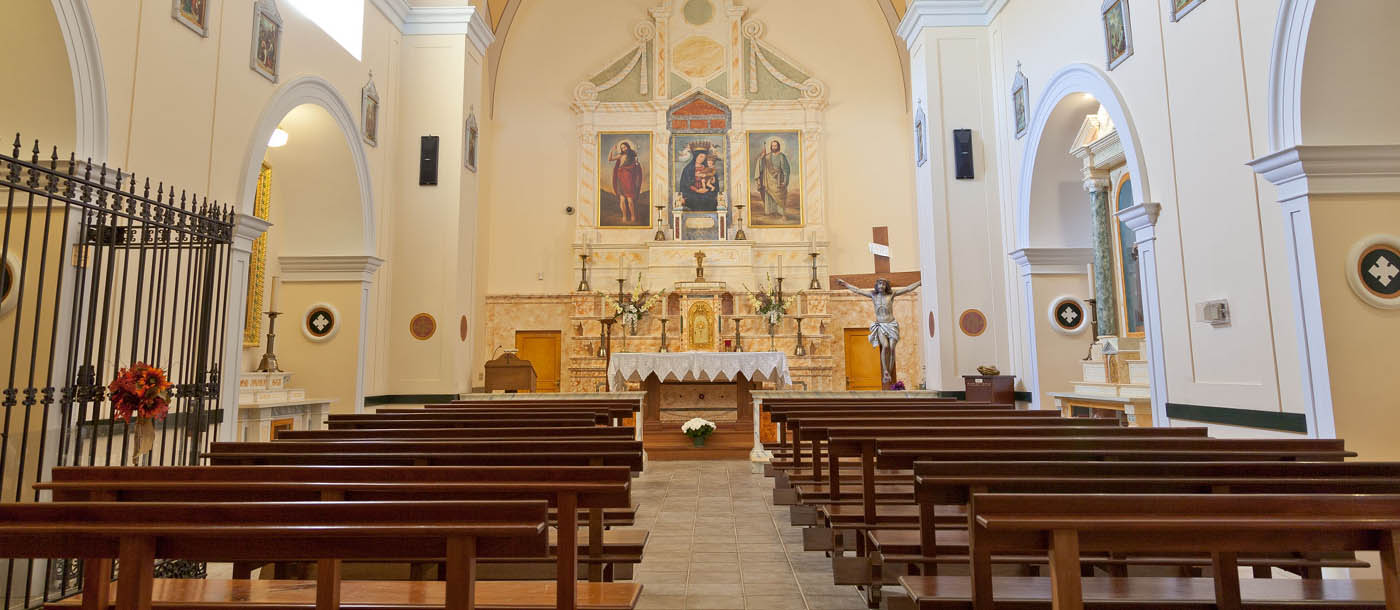
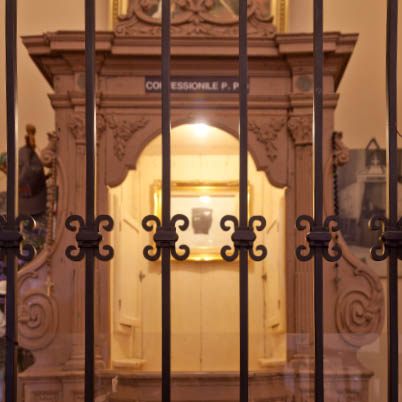
Our Lady of Grace Chapel
Located at the National Centre for Padre Pio, the Our Lady of Grace chapel is an architecturally and historically accurate replica of the Madonna della Grazie (Our Lady of Grace) chapel located in the friary in San Giovanni Rotondo where Padre Pio lived most of his life as a Capuchin priest. Visitors to the Centre’s chapel are transported to a time when monasticism played a more significant role in the lives of Catholic believers.
Visitors to Our Lady of Grace Chapel at the National Centre for Padre Pio are greeted by the carved symbol of the Franciscans over the Chapel’s main door: crossed arms over the cross of Christ. Directly below the Franciscan symbol is a colorful tile portrait of Saint Francis of Assisi, the Virgin and Child, and Saint Michael the Archangel. Upon entering the small but inspiring chapel, visitors will find tiled floors and a domed ceiling, masterfully recreating the original Italian architecture. The cream-colored walls are enlivened by geometric designs and formed by the gracious curves of the arches trimmed in white and gold.
Pray Like Padre Pio Prayed
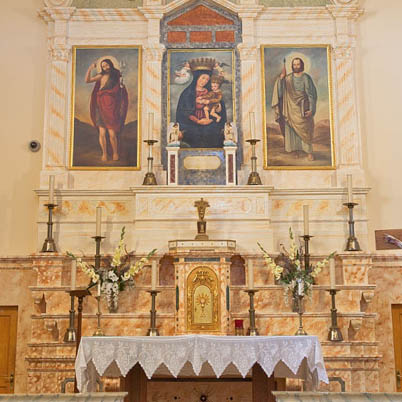
The main altar, recessed amidst the vaulting arches of the largest alcove in the chapel, is carved to give the appearance of polished marble. A golden tabernacle topped with a crucifix is centrally located on the main altar. Both are situated below renditions of the three famous paintings original to the chapel in San Giovanni Rotondo.
Moving from left to right, Saint John the Baptist is the subject of the first of the three paintings, whose special feast day is celebrated in San Giovanni Rotondo every June 24. Wearing his traditional animal fur, the symbol of his total spirit of abandonment to God’s holy will, and wrapped in a red cloth as a symbol of his martyrdom, he holds a staff topped with a cross draped in white cloth, symbolizing the death and resurrection of Jesus.
The subject of the center painting is Our Lady of Grace, who holds the Christ Child. Both mother and Son are crowned in glory and adorned by angels. Padre Pio had a great devotion to this painting, and he often emptied his heart before it in supplication to the Christ Child and His holy mother.
On the far right hangs a painting of Saint Paul the Apostle, Padre Pio’s favorite author from Sacred Scripture. In one hand he holds a spear, perhaps suggesting his martyrdom as well as the Word of God which pierces hearts. In the other hand, Saint Paul cradles a text which represents the writings of Sacred Scripture.
“The earth could exist more easily without the sun
than without the Holy Sacrifice of the Mass.”
Moving from the main altar to the first side altar on the right of the chapel, Saint Francis of Assisi resides with his stigmatized hands crossed lovingly over his heart. Below him lies an image of Saint Massimiana, virgin and martyr. Although she is no longer on the official church calendar, the people of San Giovanni Rotondo still venerate this local martyr, regarding her with great affection.
The second side altar on the right side of the chapel is devoted to Saint Felix Cantilice. A humble Capuchin, Saint Felix had been responsible for answering the door to the friary. His great gifts of humility and holiness were matched by the supernatural gifts of prophesy and holding the Christ Child, as depicted by Our Lady offering her Son to the open arms of St. Felix, while he is being crowned with sanctity by a cherub.
“If we only knew how God regards this Sacrifice,
we would risk our lives to be present at a single Mass.”
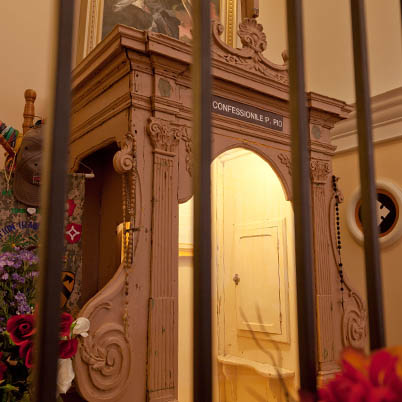 The first side altar on the left of Our Lady of Grace Chapel celebrates Our Lady under Her title of The Immaculate Conception. Here, the Mother of Jesus stands below God the Father, as the New Eve, crushing the head of sin, depicted as Satan in the form of a serpent.
The first side altar on the left of Our Lady of Grace Chapel celebrates Our Lady under Her title of The Immaculate Conception. Here, the Mother of Jesus stands below God the Father, as the New Eve, crushing the head of sin, depicted as Satan in the form of a serpent.
The last side altar on the left side of the chapel houses an actual confessional used by Padre Pio, in San Giovanni, to hear the confessions of the women. It is ironic that this confessional would be the one to find its way to America through the efforts of one woman who wanted to thank the holy stigmatist for healing her daughter. Because of the confessional’s historic significance and sacred nature, it is surrounded with a black wrought iron fence to protect it from harm.
“As long as you receive Jesus in the Blessed Sacrament every morning,
you must consider yourself extremely fortunate.”
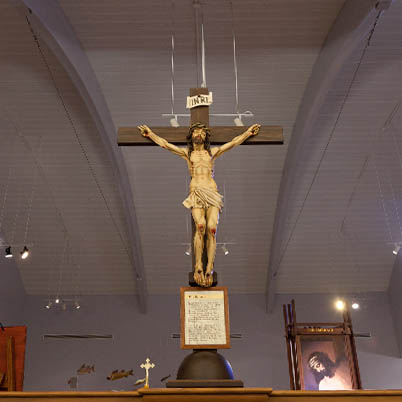
An elegant choir loft (not pictured) overlooks Our Lady of Grace Chapel, creating an atmosphere which is both intimate and sacred, replicating the place where Padre Pio received the five visible wounds of Christ crucified in 1918. The choir loft is framed by spacious domes and arches, and a stunning crucifix rises from the center of its banister. Unlike the original in San Giovanni Rotondo, this one is turned towards the interior of the chapel, so that visitors may gaze upon this replica of the crucifix in front of which Padre Pio was kneeling when he received the visible stigmata.
Visit the National Centre of Padre Pio to see Our Lady of Grace Chapel and other spiritual spaces.
Visit the Centre
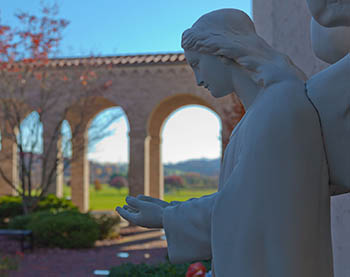
Plan your group pilgrimage or individual visit to the National Centre for Padre Pio.
Donate Now
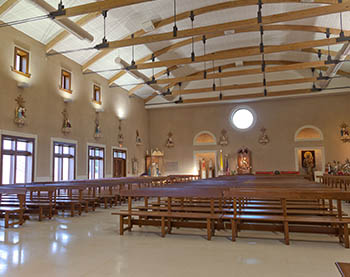
Make a real and lasting contribution to the continuation of Padre Pio’s legacy.
Explore the Centre
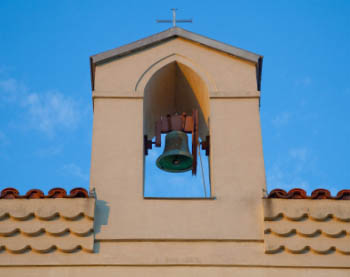
View our photo gallery to see the Centre’s spiritual sites, shrines, and grounds.